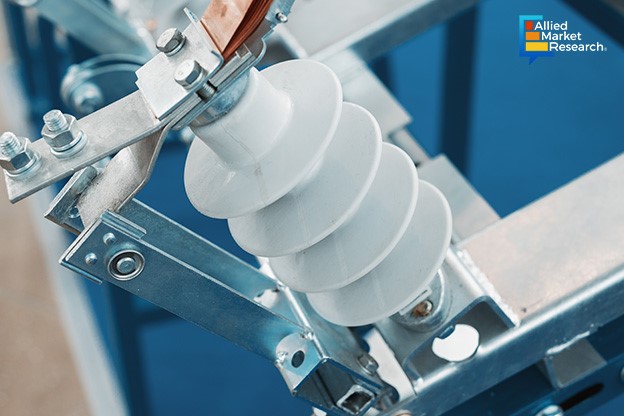Why Are Power Transmission Companies Increasingly Opting for Composite Insulators?

25 Jul
2024
Highlights:
- Introduction
- Growing preference for composite insulators
- The growth of the landscape in the Asia-Pacific region
The safety of an electrical machine or appliance depends on the protection offered to the conductor. An exposed cable or wire is prone to accidents like short circuits, voltage fluctuations, current overflow, etc. To tackle this problem, electrical conductors are generally covered with insulators made from resilient materials that can withstand mechanical stress and harsh environmental conditions such as rain, heat, and frost. Over the years, with advancements in material science, several new insulators have been designed and developed to protect overhead and underground power lines and electrical cables. Of these recently developed insulating materials, composite insulators are quite in demand.
Reasons behind the growing approval for composite insulators in the field of electrical equipment maintenance
Traditionally, insulators used for high-voltage power transmission cables were made from glass or porcelain. While they are still widely used in many countries for overhead supply lines, their limitations have become quite apparent in the past few decades. These insulators face the problem of tracking, i.e., overaccumulation of electrically charged particles which leads to leakage of current, resulting in premature failure. The problem of tracking is especially common in areas with wet and humid conditions. Also, these insulating materials face challenges regarding environmental stress cracking (ESC) due to constant exposure to sunlight and high temperatures. Moreover, pollutants like dust, particulate matter, and soot reduce the insulating properties of these materials, which compromises the protection of the electrical conductor.
To overcome these challenges, composite insulators were developed in the 1970s in Germany. As the demand for electricity has increased exponentially in the past few years, the applicability of composite insulating materials has surged. Composite insulating materials essentially have a high tensile strength of around 500 MPa, which is approximately 7-8 times that of porcelain. At the same time, these insulators are extremely lightweight which makes them perfect for overhead lines. Also, they are easier to install and repair, thus reducing the costs associated with maintenance and power outages.
Recently, composite insulating materials such as silicone rubber have been developed which has become widely popular due to its hydrophobic properties. The micro-molecules present in this advanced insulator prevent the water from forming a film, thereby helping in the smooth conduction of electricity. Moreover, the diameter of composite insulators is quite small as compared to conventional ones. Due to their size and flexibility, the chance of breakage in composite insulating materials is quite low. Additionally, these materials have excellent seismic performance and high stain resistance. As a result, they are ideal for use in areas with harsh weather conditions and disaster-prone regions. Finally, these composite insulating materials, like silicone rubber, are more resistant to electric erosion and tracking, making them more useful in electrical power generation systems.
The Asia-Pacific region generating new opportunities for growth in the landscape
In the past few years, composite insulators have been used in different end-use sectors such as railways, telecommunication, and power transmission. As a result of the widespread applicability of these advanced insulating materials, the composite insulators industry is predicted to grow immensely in the near future. Technological advancements in the field of material science are anticipated to create new opportunities for growth in the sector. The Asia-Pacific region is estimated to have the fastest CAGR of 4.70% from 2023 to 2032. The growing energy demand due to the rapid pace of industrialization and urbanization in the developing countries of this province is projected to play a major role in the rise of this industry. Furthermore, the increasing focus on renewable and sustainable energy is expected to positively impact the landscape globally.
The innovative products unveiled by major companies are anticipated to contribute to the industry’s rise. For instance, in March 2023, Shin-Etsu Chemical Co., Ltd., the largest chemical company in Japan, announced that it had developed a new silicone rubber insulator for covering high-voltage cables in automobiles. The product launch is expected to help the company expand its footprint in the industry in the years to come.
To summarize, the composite insulators industry is expected to have a healthy growth rate in the coming period on account of the rising demand for these advanced insulating materials from different end-use industries. Furthermore, the advantages offered by composite insulators over traditional ones have made them an ideal choice for the power transmission sector.
To understand the changing dynamics of the composite insulators industry, feel free to contact us.

Akhilesh Prabhugaonkar
Author's Bio- Akhilesh Prabhugaonkar holds a bachelor’s degree in Electronics Engineering from the reputed Vishwakarma Institute of Technology. He has a special interest in the fields of forensics, world history, international relations and foreign policy, sports, agriculture, astronomy, security, and oceanography. An ardent bibliophile and melophile, Akhilesh loves to write on topics of his interest and various other societal issues. This love for writing made him enter the professional world of content writing and pursue his career in this direction.
Avenue: Entire Library membership of Allied Market Research Reports at your disposal
- Avenue is an innovative subscription-based online report database.
- Avail an online access to the entire library of syndicated reports on more than 2,000 niche industries and company profiles on more than 12,000 firms across 11 domains.
- A cost-effective model tailored for entrepreneurs, investors, and students & researchers at universities.
- Request customizations, suggest new reports, and avail analyst support as per your requirements.
- Get an access to the library of reports at any time from any device and anywhere.
Related Post
-
How are Submarine Cables Transforming Global Connectivity with Enhanced User Experience?
-
Endoscopy Procedures: Transformations in Techniques and Applications
-
AI-Powered Video Analytics: How the Product Actually Works for enterprises
-
Painting Robots: Transforming Precision Coating and Creative Applications
-
Innovations in Pharmacovigilance Systems Advancing Patient Safety
-
Understanding Edge Security: Keeping Data Safe Near the Source
-
Exploring the Use and Advancements of 3D Laser Scanners in Professional Applications
-
Reinforcing Industrial Controls with Smarter Tools and Training








